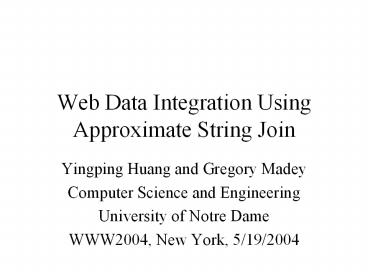Web Data Integration Using Approximate String Join - PowerPoint PPT Presentation
Title:
Web Data Integration Using Approximate String Join
Description:
Web Data Integration Using Approximate String Join Yingping Huang and Gregory Madey Computer Science and Engineering University of Notre Dame WWW2004, New York, 5/19/2004 – PowerPoint PPT presentation
Number of Views:95
Avg rating:3.0/5.0
Title: Web Data Integration Using Approximate String Join
1
Web Data Integration Using Approximate String Join
- Yingping Huang and Gregory Madey
- Computer Science and Engineering
- University of Notre Dame
- WWW2004, New York, 5/19/2004
2
Introduction
- Web data integration is an important
preprocessing step for web mining and data
analysis. - Approximate string processing is a fundamental
step in many existing data cleansing algorithms. - Approximate string join seeks to identify
(almost) all pairs of strings whose distances are
less than a certain threshold. - Typical string distances include edit distance,
q-gram distance and vector cosine similarity.
3
Related Work
- Li (2003) proposed a mapping algorithm where each
string is mapped to a point in a high dimensional
euclidean space using FastMap. Then a similarity
join algorithm proposed by Hjaltason and Sanel
(1998) is used to identify close points. - Gravano (2003) presented a sampling approach for
performing text join where each string is
represented by a sparse vector in a high
dimensional space. Then a join is performed on
the resulting vector space.
4
Drawbacks of Previous Approach
- In Li (2003), the similarity join algorithms is
computationally sensitive to the dimensionality
of the hosting space. When the dimensionality
gets large, the similarity join algorithms
becomes very inefficient. - In Gravano (2003), the sampling method uses a
lower dimensional subspace for join. The accuracy
of this approach depends on the dimensionality of
the subspace. Usually, to obtain a high accuracy,
the dimensionality of the subspace is close to
the dimensionality of the original space.
5
Our Approach
- We first form the database of strings to be a
(1,2)-B metric space and then map the (1,2)-B
metric space into a high dimensional grid space. - Pairs of points with distance 1 are identified in
the grid space. Any two points in the grid space
have distance 0, 1, or 2. - A post join process is performed to remove false
positives.
6
(1,2)-B Metric Space
- A metric space M(X,D) is called a (1,2)-B metric
space, if the distance between any two points is
either 0, 1, or 2, and for any point in X, there
are no more than B points within distance 1. - For any two strings s and t, if their string
distance is less than k, then we define their new
distance to be 1, otherwise, we define their
distance to be 2. We also assume that each string
has at most B other strings that have string
distance less than k.
7
Lemma
- Guruswami (2003) proved that a (1,2)-B metric
space can be isometrically embedded into a high
dimensional grid space, with dimensionality
O(BlogN) where N is the size of the string
database. - An approximate matrix multiplication method is
used to construct the actual mapping.
8
Results
The precision and recall are both reasonably good.
9
Summary
- The previous figure shows that our approach
achieves good precision and recall. - It has some potential advantage over the
algorithms presented by Li (2003) and Gravano
(2003). - The execution time is almost linear to the
dimensionality of the hosting grid space.
10
References
- Li (2003) L. Jin, C. Li and S. Mehrotra.
Efficient record linkage in large datasets. In
Proc. 8th international conference on database
systems for advanced applications. - Gravano (2003) L. Gravano and P. Ipeirotis. Text
join in an rdbms for web data integration. Proc.
12th international WWW conference. - Guruswami (2003) V. Guruswami and P. Indyk.
Embeddings and non-approximability of geometric
problems. In Proc. 14th Annual ACM-SIAM Symposium
on Discrete Algorithms.































